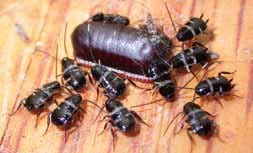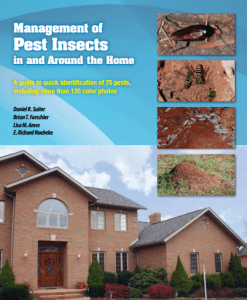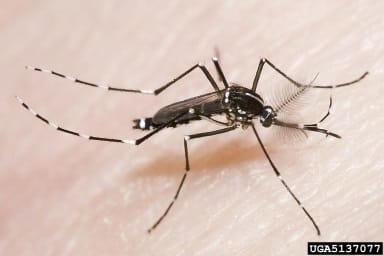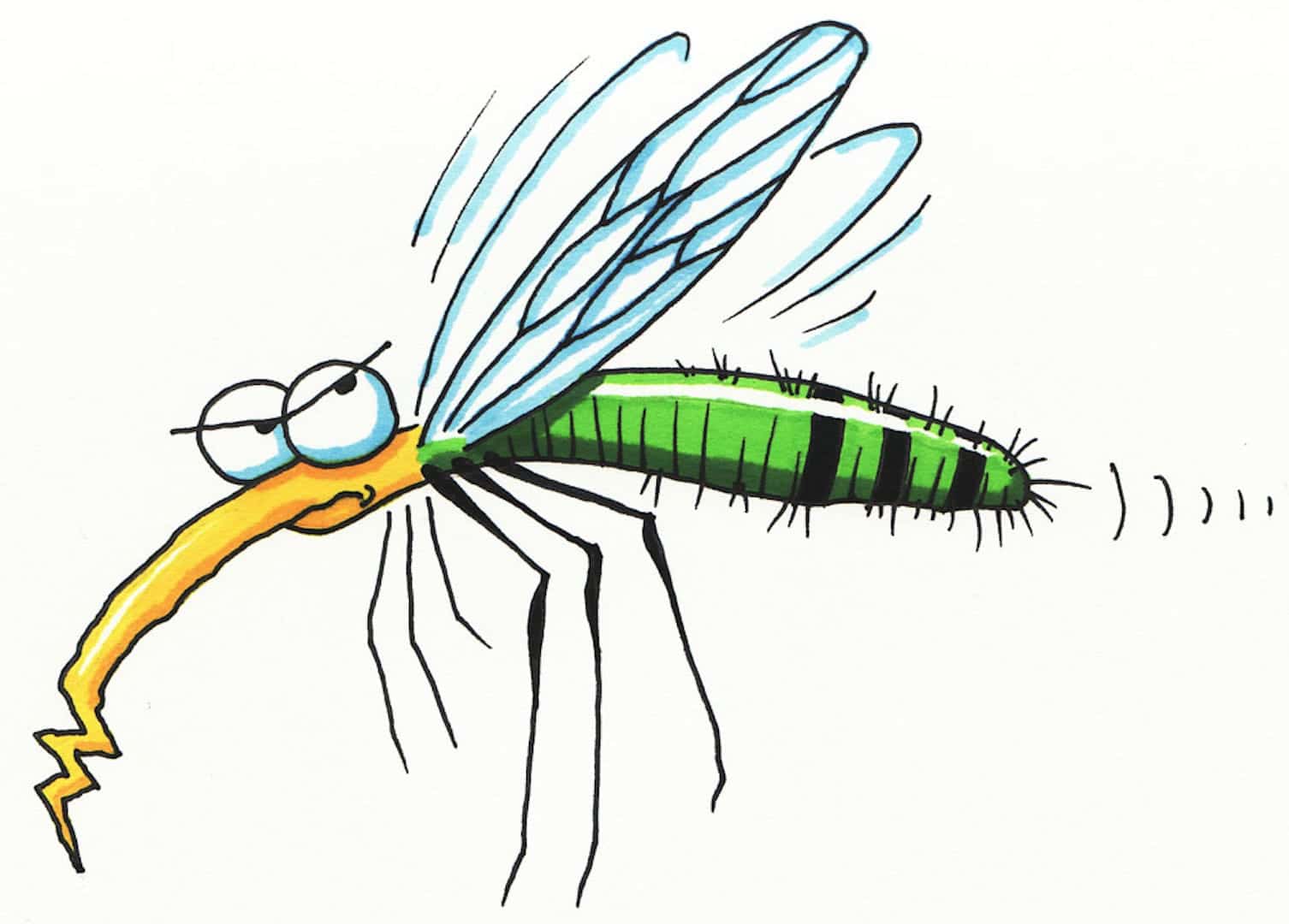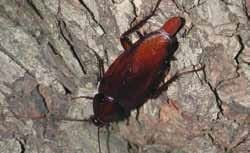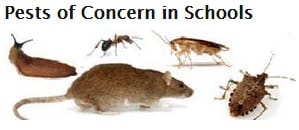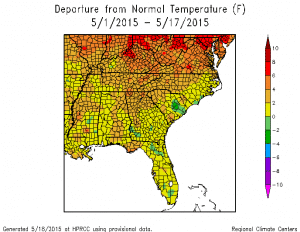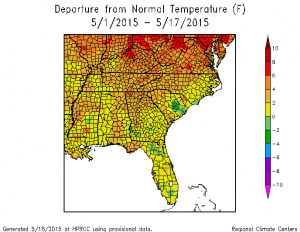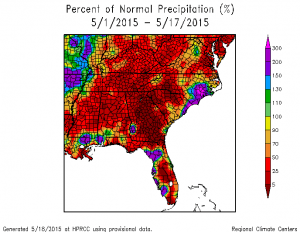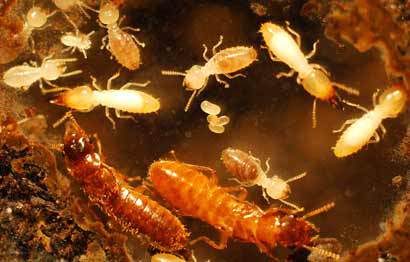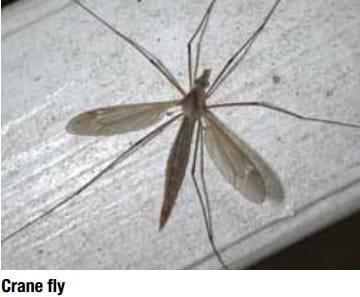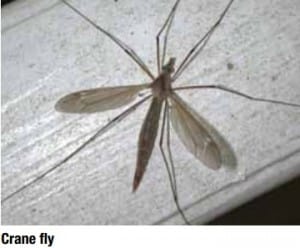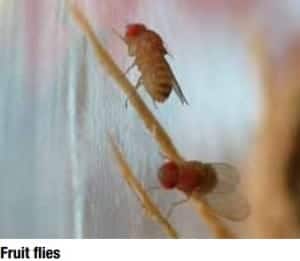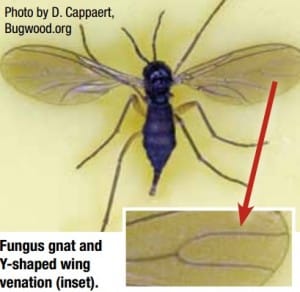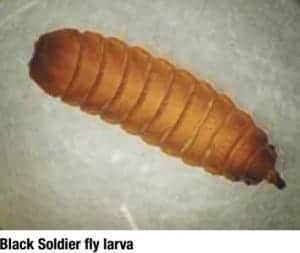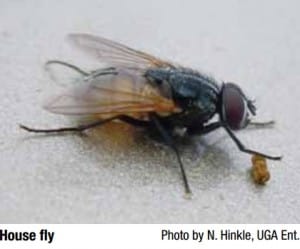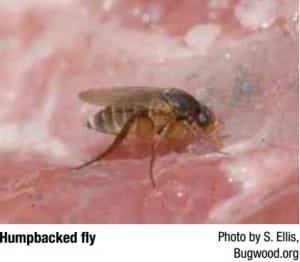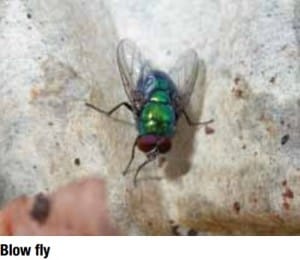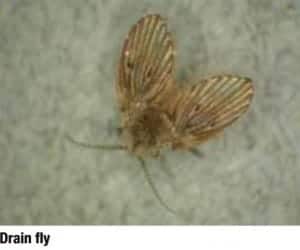The Pest Control Alert is an email newsletter and blog from UGA for the structural pest control industry. These Alerts are designed to anticipate industry needs and to use UGA resources to address emerging issues like pesticide resistant insects, integrated pest management of emerging pests (Africanized bees, kudzu bugs, Formosan termites, etc.) and pesticide regulatory changes. The newsletter is coordinated by the Center. The key contributor to the Alerts, the Urban Pest Management Program at the UGA Griffin campus, responds to challenges with up-to-date research, reports and trainings.
The Pest Control Alerts are emailed to nearly 500 people, many of whom share the information with co-workers. An on-line readers survey indicates that 96% of those responding have learned something they plan to use from the Alerts. The Alerts are impacting the Georgia structural pest control industry!
Examples of industry comments on the Pest Control Alerts include "Timely news - your site DELIVERS!" and "Keep them coming."
Extension personnel comments include "I ... always learn from your alerts. Our industry professionals also love to receive it as I pass it on to all of them." "Our office staff and Master Gardener Volunteers use these pest control alerts to educate themselves for our clients. These alerts let us know what is out there."
For more information email ebauske@uga.edu or dsuiter@uga.edu.
Latest Pest Control Alerts
Zika Virus and Outdoor Workers: Include Insect Repellent on your list of PPE (Personal Protective Equipment)
Inherently, agricultural and outdoor workers experience a greater risk of mosquito bites that can vector illnesses such as chikungunya, dengue, Japanese encephalitis, West Nile, and Zika virus disease. The CDC and EPA recommend using EPA-registered insect repellents containing DEET, picaridin, IR3535, oil of lemon eucalyptus, or para-menthane-diol to protect workers against these infections. Fact sheets and posters have been released by the Centers for Disease Control & Prevention, Occupational Safety and Health Administration (OSHA) and the National Institute for Occupational Safety and Health (NIOSH) outlining the Zika virus to promote education and communication regarding practices to reduce worker exposure.
Limit Access to Food to Practice Proactive Pest Management
Pest Management
Taken from the UGA publication Management of Pest Insects in and Around the Home by Daniel R. Suiter, Brian T. Forschler Lisa M. Ames and E. Richard Hoebeke
The origin and extent of a pest infestation is often associated with one or more conditions that promote the survival and reproduction of that particular pest. Those conditions include:
- Favorable temperatures,
- Abundant food and water, and
- Available shelter or harborage
When pest problems occur there is usually one or more of these requirements readily accessible to the pest.
The preferred living environment for most humans also provides the necessities many pests need to satisfy their life support requirements. Therefore, it is important that homeowners limit pest access to potential sources of food, water, and shelter in and around the home in an effort to keep our personal living space inhospitable to unwanted house pests.
Proactive pest management is a process that begins with identifying the pest and using information on the biology of the offending creature to decide upon a plan of action. The action plan should involve interventions aimed at reducing pest population numbers or the chance for future encounters with that pest.
Proactive pest management interventions will vary from one household or business to the next but there are a few overarching themes worthy of comment. (Editors note: We discuss access to food in this article. For information on other proactive pest management refer to the publication Management of Pest Insects in and Around the Home)
Food
General rules of cleanliness during food preparation, storage and disposal is the logical starting point for helping to resolve and prevent certain pest problems. Denying pests access to food is an important component of making our living environment less hospitable to pests.
 Important practices (habits to establish) that may limit insect access to food include, but are not limited to:
Important practices (habits to establish) that may limit insect access to food include, but are not limited to:
- Keep food in tightly sealed containers;
- Keep bird food in feeders, as rodents may use spilled food as a food source (Figure 1);
- Rotate (use) boxed or packaged foods every 1-2 months;
- Clean up spills that occur during food preparation or handling;
- Do not keep soiled dishes in the sink or dishwasher overnight;
- Empty indoor garbage receptacles twice per week, at a minimum;
- Clean garbage disposals at least once a week;
- Keep outdoor garbage in a tightly sealed container and away from any dwelling entrance;
- Rinse recyclable containers prior to recycling;
- Store birdseed in a tightly sealed container, preferably outside and away from doors;
- Ensure that discarded plant waste is removed twice per week, at a minimum, especially during the summer (Figure 2).
For more information on Proactive Pest Management see Management of Pest Insects in and Around the Home
About the Authors
Daniel Suiter (dsuiter@uga.edu) and Brian Forschler (bfor@uga.edu) are Professors of Entomology, specializing in urban entomology, in the Department of Entomology at the University of Georgia; Suiter is located on the university’s campus in Griffin, while Forschler is on the main campus in Athens, Ga.
Lisa Ames (lames@uga.edu) directs the Homeowner Insect and Weed Diagnostics Laboratory on the UGA Griffin Campus.
Richard Hoebeke, a systematic entomologist, is the associate curator of insects at the Georgia Museum of Natural History on the UGA’s main campus in Athens, Ga (rhoebeke@uga.edu).
Home IPM Workshop planned for August 13
UGA Urban Pest Management Program
Home IPM Workshop
Thursday, August 13 ~ UGA-Griffin Campus
Georgia Credit (credit also available in FL, AL, SC, TN)
5 HPC Hours (Cert/Reg)
The registration fee ($75) includes the 1 day workshop, instructional materials, lunch, and refreshments during the course of the workshop.
IPM Workshops are limited to 25 participants, so register early to reserve your spot!
Urban and structural pest management is the protection of property, food, and health from insect and rodent pests commonly found in homes, restaurants, and other businesses. The goal of this workshop is to teach participants how to generate and interpret the information required for effective Integrated Pest Management (IPM) programs.
The IPM Workshop Program addresses the development of critical thinking skills required for pest management professionals to develop an IPM mindset. Workshop programming addresses, through classroom lectures and discussion, on-site demonstrations, identification laboratories, and interactive field activities, such topics as:
- Logical components of IPM programs
- Inspections: The driving force and cornerstone of the IPM process
- Inspection tools and techniques
- Decision making – when to treat, not treat, or do nothing
- Using trap data in the decision-making process
- The role of pesticides in IPM
A Unique Training Opportunity. An insect identification laboratory is part of the workshop. During the laboratory session, participants will see dozens of pest species, and/or signs of their presence, commonly found in and around Georgia’s urban environment.
Completion of the 1-day workshop provides 5 HPC hours (Cert/Reg) and 4 hours credit in Category 35. A “Certificate of Completion” will be awarded at the completion of the workshop.
Find more info here or contact Dr. Daniel Suiter at 770-233-6114.
Georgia’s Arboviral Survey results available in the Georgia Mosquito Control Association newsletter
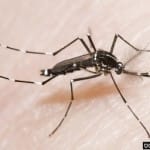
In 2014, Georgia reported 13 human cases of West Nile Virus (WNV), with 1 death. Eleven (84.6%) of the 13 cases experienced WNV neurologic illness (altered mental status, paralysis, encephalitis, and/or meningitis) and 2 (15.3%) were diagnosed with WNV fever.
Survey
See the entire survey in the May edition of DIDEEBYCHA, the newsletter of the Georgia Mosquito Control Association.
Online Video Helps Prepare Pesticide Applicators to Pass the Mosquito Control Exam
Willie Chance, UGA Center for Urban Agriculture and Elmer Gray, UGA Entomology Department
Mosquito Control is a growing part of the landscape industry. Commercial applicators of mosquito control products need to have pesticide applicator certification in Category 41, Mosquito Control. UGA Entomologist Elmer Gray has recorded an online video to better prepare applicators to take and to pass the Category 41 pesticide exam.
The new online video
Prepare applicators to take the Mosquito Control (Category 41) exam at www.gamosquito.org/training.html
[youtube https://www.youtube.com/watch?v=nwd8MRvgF1k]
Note that the video is a supplemental help to those studying for the exam and is not a replacement for studying the manual! Applicators should order and study the manual before taking the exam.
If the applicator has not already passed the general standards exam through the GA Dept of Ag Pesticide Division, they will also need to order that manual, study and also pass that exam as well.
Find more information on the Georgia Department of Agriculture pesticide division and applicator licenses.
Water is the condition allowing many household pests to persist
Info taken from Management of Pest Insects in and Around the Home
Water
Excessive, persistent moisture is the most important condition allowing many types of pest infestations to establish and persist.
Not only is water critical to the health and normal metabolism of all forms of life, its abundance leads to the growth of various molds, fungi, and other microorganisms which are the primary food source for numerous insect species.
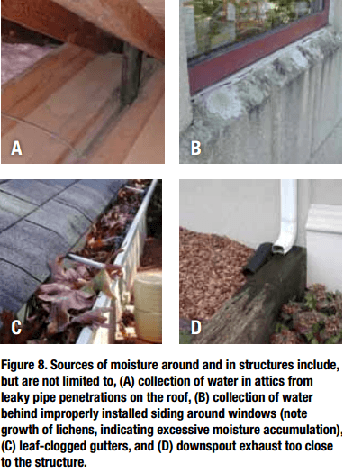 Homeowners should limit the occurrence of persistent moisture in and around their home. Moisture problems can only be remedied by correcting the underlying cause(s). Some common sources of excessive, or persistent, moisture that may lead to a pest problem include but are not limited to:
Homeowners should limit the occurrence of persistent moisture in and around their home. Moisture problems can only be remedied by correcting the underlying cause(s). Some common sources of excessive, or persistent, moisture that may lead to a pest problem include but are not limited to:
- Leaking faucets or water lines;
- Condensation, for example on pipes, in walls and under insulation;
- Improper ventilation of walls, attics, crawlspaces, or basements;
- Roof leaks, especially those that are the result of improperly installed flashing around pipe penetrations, sky lights, and chimneys (Figure 8A);
- Improper landscape grade resulting in poor surface water drainage patterns;
- Misdirected sprinkler heads;
- Gaps around windows (especially bay windows) and doors that allow water behind the structure’s exterior sheathing (Figure 8B);
- Clogged gutters and downspouts (Figure 8C);
- Downspout and air conditioner drain lines that deposit water within five feet of the structure (Figure 8D).
Property owners should ensure that:
- Rainwater flows away from their home by examining the grade or slope of the landscape to make certain it is appropriate;
- Gutters, downspouts, roof, and air conditioner condensate drainage patterns are operating properly and depositing water away from the foundation;
- Attics, crawlspaces, and basements are properly ventilated;
- A vapor barrier is in place in the crawlspace;
- Sprinklers are positioned properly;
- There is no standing water or persistent wet spots next to the foundation or in the crawlspace.
For more information see Management of Pest Insects in and Around the Home
Pest Management: EPA’s Managing Pests in Schools Website Updated
 As part of EPA’s ongoing effort to build a more user-friendly website, we have transformed our Managing Pests in Schools website into a new, easy-to-use format. Information on school Integrated Pest Management (IPM) should now be easier than ever to access, regardless of the type of electronic device being used, including tablets and smartphones.
As part of EPA’s ongoing effort to build a more user-friendly website, we have transformed our Managing Pests in Schools website into a new, easy-to-use format. Information on school Integrated Pest Management (IPM) should now be easier than ever to access, regardless of the type of electronic device being used, including tablets and smartphones.
Integrated Pest Management
IPM is an effective and environmentally sensitive approach that offers a wide variety of tools to reduce contact with pests and exposure to pesticides. The website focuses on providing vital information in the school setting for parents, school administrators, staff and pest management professionals. Knowledgeable, proactive stakeholders can help a community prevent or significantly reduce risks from pests as well as unnecessary pesticide use.
The website is organized into the following areas:
- About Integrated Pest Management in Schools
- Establishing Integrated Pest Management Programs
- Pests of Concern in Schools
- IPM Training and Certification
The old Web pages will redirect to the new website, and we encourage visitors to update their bookmarks with the new URLs.
The address for the new website is www2.epa.gov/managing-pests-schools
May has been warmer and drier
May 2015 is half over and it is time to see how the monthly climate is doing so far. The maps from the High Plains Regional Climate Center below show that for the region as a whole, temperatures are running about 1.5 degrees above the 1981-2010 normal, while the precipitation is much below normal and in some areas none has fallen at all, which is shown on the “percent of normal precipitation” map as an area of dark red, indicating zero percent of normal rainfall for the month. Atlanta broke their record for the driest start to May before finally getting rain on 5/17. Athens, GA is the driest May to date on record and Macon is tied for the driest, although rain is likely at both locations this week.
For the rest of the month, warmer than normal temperatures are expected to continue. Rainfall is expected to increase and may even be above normal for the rest of the month, although it will be spotty.
Florida Scientists Discover Super Termites, and They’re Not Genetically Modified
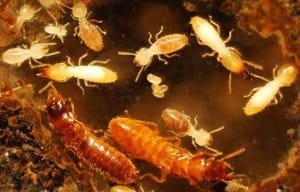
Edited from Florida Scientists Discover Super Termites, and They’re Not Genetically Modified in Entomology Today
Author Richard Levine is Communications Program Manager at the Entomological Society of America and editor of the Entomology Today Blog.
Formosan subterranean termites (Coptotermes formosanus) and Asian subterranean termites (Coptotermes gestroi) are the most damaging pest species in the world. Both are highly invasive and have spread throughout many areas of the world due to human activity, and their distributions overlap in some areas.
Hybrid Termites
Now scientists in Florida have observed Formosan males mating with Asian females — in fact, they seem to prefer the Asian females more than females from their own species — and their hybrid offspring seem to grow colonies twice as fast as their parents. Their findings are published in the journal PLOS ONE, and are described in this video.
Many hybrids are unable to reproduce (the mule, for example, which is the sterile hybrid offspring of a male donkey and a female horse). And many hybrids that actually can reproduce tend to lose vigor after one or more generations, which is why farmers often buy new hybrid seeds each growing season.
But so far that doesn’t seem to be the case for these termite hybrids. In the laboratory, the Florida researchers are raising a hybrid colony that is growing twice as fast as same-species colonies, suggesting a potential case of hybrid vigor.
“Our hybrid colony is still showing high vigor, can potentially live up to 20 years, and can still cause a significant amount of damage,” said Dr. Thomas Chouvenc, a co-author from the UFL’s Ft. Lauderdale Research and Education Center.
While these laboratory observations remain to be confirmed in the field, the results still raise a concern about the hybridization of these incredibly destructive pests, which could have significant economic impacts, according to the authors.
To get an idea of how potentially destructive they could be, watch this video of University of Florida researchers observing both termite species swarming and mating simultaneously.
Flies: Managing pests in and around homes
For more information see the publication from which this information comes, Management of Pest Insects in and Around the Home by Daniel R. Suiter Brian T. Forschler Lisa M. Ames E. Richard Hoebeke
MailChimp Signup Form
Oh no...This form doesn't exist. Head back to the manage forms page and select a different form.Categories
- Announcement (3)
- Articles (250)
- Charity (1)
- Community and School Gardening in Georgia (262)
- Community Gardening (174)
- Diseases (10)
- Fruits (14)
- Insects (57)
- Pollinators (15)
- School Gardening (112)
- Urban Agriculture (189)
- Urban Gardening (175)
- Vegetables (92)
- garden diseases; plant disease; vegetable disease (2)
- Green Industry (1)
- Landscape Alerts (215)
- Annual Flowers (11)
- Business Issues (7)
- Design and Installation (5)
- Fertilization (5)
- Integrated Pest Management (24)
- Invasive Pests (5)
- Lawns and Turf (64)
- Maintenance (10)
- Native Plants (1)
- Perennial Flowers (9)
- Plant Diseases (32)
- Pollinators (2)
- Pruning (4)
- Shrubs (16)
- Training and Events (21)
- Trees (30)
- Water (8)
- Weather (8)
- Weed Control (31)
- Oral History (3)
- Fairmont History (1)
- Retired Faculty (1)
- UGA Griffin (1)
- Pest Control Alerts (166)
- Ants (10)
- Bed bugs (2)
- Biological Insect Control (6)
- Biting Pests (12)
- Certification (12)
- Insect Related Diseases (17)
- Integrated Pest Management (21)
- Mosquitoes (23)
- Nuisance Pests (16)
- Pesticide Application (48)
- Quizes (20)
- Spiders (3)
- Stinging Pests (11)
- Stored Food Pests (2)
- Termites (5)
- Ticks (2)
- Training (13)
- Weather (24)
- Wildlife Management (1)
- Pizza Farm (1)
- Pollinators (2)
- Saw Safety (31)
- Training (5)
- Uncategorized (31)
Archives
- July 2023 (1)
- September 2022 (1)
- July 2022 (1)
- February 2022 (1)
- June 2021 (1)
- May 2021 (1)
- March 2021 (1)
- February 2021 (3)
- January 2021 (2)
- October 2020 (3)
- August 2020 (1)
- July 2020 (1)
- May 2020 (2)
- April 2020 (1)
- February 2020 (1)
- November 2019 (2)
- October 2019 (1)
- September 2019 (3)
- August 2019 (3)
- July 2019 (3)
- June 2019 (3)
- May 2019 (4)
- April 2019 (5)
- March 2019 (2)
- February 2019 (5)
- January 2019 (3)
- December 2018 (3)
- November 2018 (4)
- October 2018 (3)
- September 2018 (2)
- August 2018 (4)
- July 2018 (5)
- June 2018 (3)
- May 2018 (4)
- April 2018 (3)
- March 2018 (2)
- February 2018 (1)
- January 2018 (4)
- December 2017 (3)
- November 2017 (4)
- October 2017 (3)
- September 2017 (4)
- August 2017 (4)
- July 2017 (3)
- June 2017 (3)
- May 2017 (6)
- April 2017 (9)
- March 2017 (9)
- February 2017 (10)
- January 2017 (9)
- December 2016 (3)
- November 2016 (10)
- October 2016 (8)
- September 2016 (11)
- August 2016 (4)
- July 2016 (3)
- June 2016 (5)
- May 2016 (4)
- April 2016 (5)
- March 2016 (6)
- February 2016 (6)
- January 2016 (6)
- December 2015 (8)
- November 2015 (4)
- October 2015 (5)
- September 2015 (7)
- August 2015 (4)
- July 2015 (2)
- June 2015 (15)
- May 2015 (18)
- April 2015 (17)
- March 2015 (22)
- February 2015 (8)
- January 2015 (12)
- December 2014 (9)
- November 2014 (16)
- October 2014 (17)
- September 2014 (14)
- August 2014 (17)
- July 2014 (25)
- June 2014 (21)
- May 2014 (24)
- April 2014 (13)
- March 2014 (14)
- February 2014 (5)
- January 2014 (4)
- December 2013 (10)
- November 2013 (6)
- October 2013 (18)
- September 2013 (261)
- August 2013 (7)
- July 2013 (5)
- June 2013 (1)
- May 2013 (1)
- April 2013 (1)
- January 2013 (2)
- October 2010 (2)

